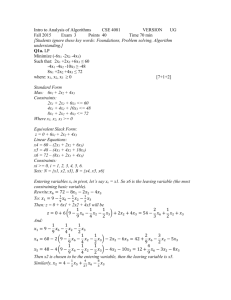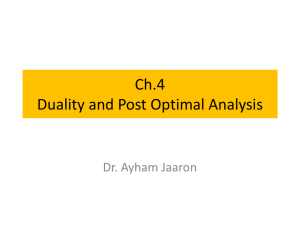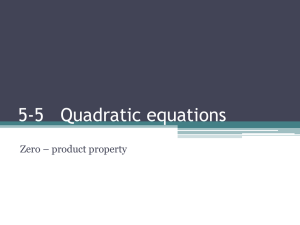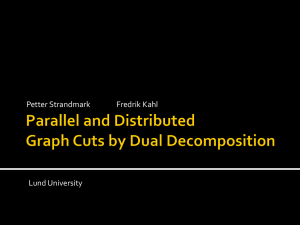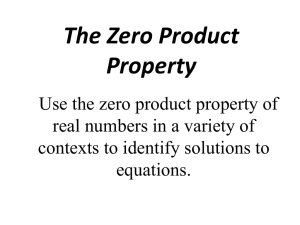x - Dalton State College
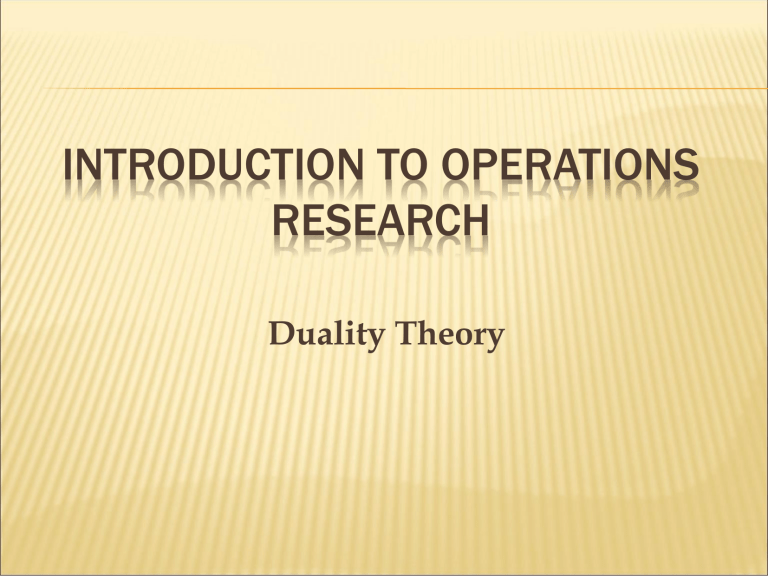
INTRODUCTION TO OPERATIONS
RESEARCH
Duality Theory
AUGMENTING THE DUAL PROBLEM
Since dual problems are also a linear programming problem, it also has CP solutions.
Since dual problems have function constraints in ≥ form, must augment by subtracting surplus variables from functional constraints.
Use surplus variable: z j
– c j for each constraint j
After augmenting dual problem:
(y
1
, y
2
, ..., y m
, z
1
-c
1
, z
2
-c
2
, ..., z n
-c n
)
PRIMAL/DUAL PROBLEMS
Primal Variable
Decision Variables: x j
Slack Variables: x n+i
Associated Dual Variable
Surplus Variables: z j
-c j
Decision Variables: y i
Complementary Basic Solution Property – Each basic solution in the primal problem has a complementary basic solution in the dual problem s.t. Z = W
Complementary Slackness Property – Given the association between variables, the variables in the primal basic solution and the complementary dual basic solution satisfy the complementary slackness relationship:
Primal Dual
Basic Non-Basic
Non-Basic Basic
WYNDOR GLASS CO. EXAMPLE
Maximize Z = 3x
1
Subject to:
+ 5x
2 x
1
+ x
3
3x
1
2x
2
+ 2x
2
+ x
4
+ x
5
= 4
= 12
= 18
Minimize W = 4y
1
Subject to:
+ 12y
2
+ 18y
3 y
1
2y
2
+ 3y
3
+ 2y
3
– ( z
1
– c
1
)
– ( z
2
= 3
– c
2
) = 5
WYNDOR GLASS CO. EXAMPLE
Optimal Solution
Dual Solution
Basic
Variable
Z x
3 x
2 x
1
Z x
0 0
1
Coefficient of: x
1 0 0
0
2 x
3
0 x
4
3/2 x
1
5
Right
Side
36
1 1/3 -1/3 2
0 0 1
0 1 0
0
0
1/2
-1/3
0
1/3
6
2
Primal Solution
WYNDOR GLASS CO. EXAMPLE
Iteration
6
7
4
5
8
1
2
3
Basic
Solution
(0,0,4,12,18) Yes
(4,0,0,12,6) Yes
(6,0,-2,12,0) No
(4,3,0,6,0)
(0,6,4,0,6)
(2,6,2,0,0)
(4,6,0,0,-6)
(0,9,4,-6,0)
Feasible?
Yes
Yes
Yes
No
No
Z=W
0
12
18
Basic
Solution
(0,0,0,-3,-5)
(3,0,0,0,-5)
(0,0,1,0,-3)
Feasible?
No
No
No
27 (-9/2,0,5/2,0,0 ) No
30 (0,5/2,0,-3,0) No
36 (0,3/2,1,0,0) Yes
42 (3,5/2,0,0,0) Yes
45 (0,0,5/2,9/2,0) Yes
COMPLEMENTARY BASIC SOLUTIONS
Complementary Optimal Basic Solutions
Property – Each optimal basic solution in the primal problem has a complementary optimal basic solution in the dual problem such that Z = W.
Satisfies Condition for Optimality?
Yes No
Feasible?
Yes Optimal Sub-Optimal
No Super-Optimal Neither Feasible nor Optimal
NONSTANDARD LP
The approach here is similar to when we dealt with non-standard formulations in the context of the simplex method.
There is one exception: we do not add artificial variables. We handle “=“ constraints by writing them as “<=“ constraints.
This is possible here because we do not require here that the RHS is non-negative.
NONSTANDARD LP
Greater than or equal to constraints:
Multiply through the inequality constraint by -1 to make it a less than constraint: x
1
( x
1
+ 2x
2
+ 2x
2
≥ 5
≥ 5 ) (-1)
-x
1
– 2x
2
≤ – 5
NONSTANDARD LP
Equality constraints:
Convert the equality constraint to a pair of inequality constraints: x
1
+ 2x
2
= 5 x
1 and x
1
+ 2x
2
+ 2x
2
≤ 5
≥ 5 x
1
-x
1
+ 2x
2
– 2x
2
≤ 5
≤ – 5
NONSTANDARD LP
Unrestricted variables:
Replace the variable unrestricted in sign, by the difference of two nonnegative variables: x
1
+ 2x
2
≤ 5 x
1 x
2
≥ 0, unrestricted x
1
+ 2(x
2
– x
2
) ≤ 5
Maximize Z = x
1
Subject to:
+ x
2
+ x
3 x
1 x
1
2x
2
– 3x
2
– 2x
2
– x
3
+ 4x
3
≥ 4
= 5
≤ 18 x
1
, x
2 x
3
≥ 0, unrestricted
EXAMPLE
Maximize Z = x
1
Subject to:
+ x
2
+ (x
3
– x
3
) x
1 x
1
2x
2
–
(x
3
– x
3
) ≥ 4
– 3x
2
– 2x
2
+ 4(x
3
– x
3
) = 5
≤ 18 x
1
– x
1 x
1
– 2x
2
– 3x
2
+ 3x
2
– 2x
2
+ x
3
– x
3
+ 4x
3
– 4 x
3
– 4x
3
+ 4 x
3
≤ –4
≤ 5
≤ – 5
≤ 18
EXAMPLE
Primal Problem
Maximize Z = x
1
Subject to:
+ x
2
+ x
3
– x
3 x
1
– x
1 x
1
– 2x
2
– 3x
2
+ 3x
2
– 2x
2
+ x
3
– x
3
+ 4x
3
– 4 x
3
– 4x
3
+ 4 x
3
≤ –4
≤ 5
≤ – 5
≤ 18
Dual Problem
Minimize W = – 4y
1
+5y
2
– 5y
3
+3y
4
Subject to:
– 2y
1
–y
1 y
1 y
2
– 3y
2
– y
3
+ y
4
+ 3y
3
– 2y
4
– 4y
2
+ 4y
3
+ 4y
2
– 4y
3
≥
≥
1
1
≥ –1
≥ 1
Dual Problem
Minimize W = – 4y
1
+5y
2
– 5y
3
+3y
4
Subject to:
– 2y
1
–y
1 y
1 y
2
– 3y
2
– y
3
+ y
4
+ 3y
3
– 2y
4
– 4y
2
+ 4y
3
+ 4y
2
– 4y
3
≥
≥
1
1
≥ –1
≥ 1
EXAMPLE
Dual Problem
Minimize W = – 4y
1
+5y
2
+3y
3
Subject to:
– 2y y
1
1 y
2
– 3y
2
+ 4y
2
+ y
3
– 2y
3
≥
≥
1
1
= 1 y
1
, y
3 y
2
≥ 0, unrestricted
Equality constraint
(y
2
– 3(y
2
– y
3
)
– y
3
)
– 4(y
2
– y
3
)
4(y
2
– y
3
)
Unrestricted variable (y
2
– y
3
)
STREAMLINING THE CONVERSION
An equality constraint in the primal generates a dual variable that is unrestricted in sign.
An unrestricted in sign variable in the primal generates an equality constraint in the dual.
Primal Problem opt=max
Constraint i :
<= form
= form
Variable j: x j x j
>= 0 urs
Dual Problem opt=min
Variable i : y i y i
>= 0 urs
Constraint j:
>= form
= form
